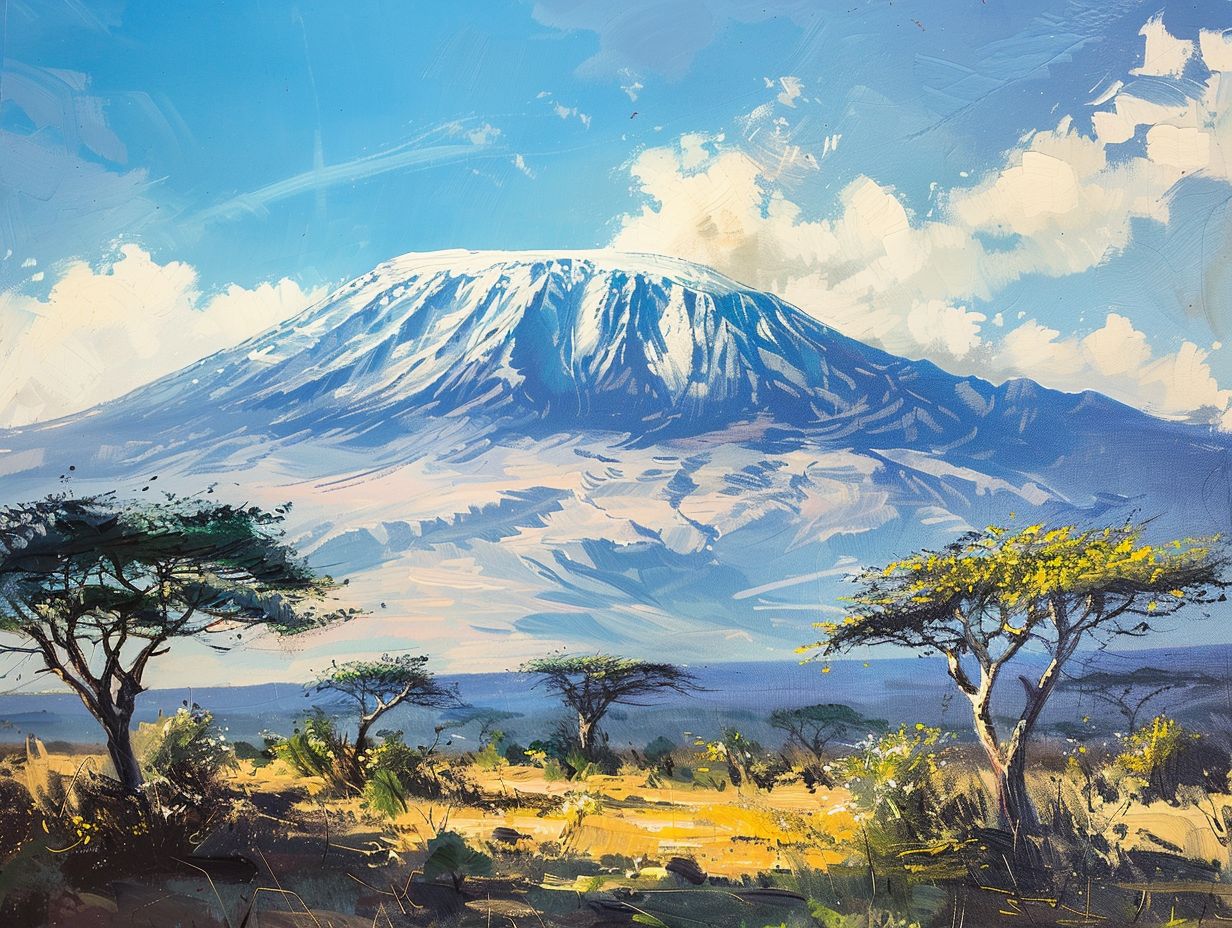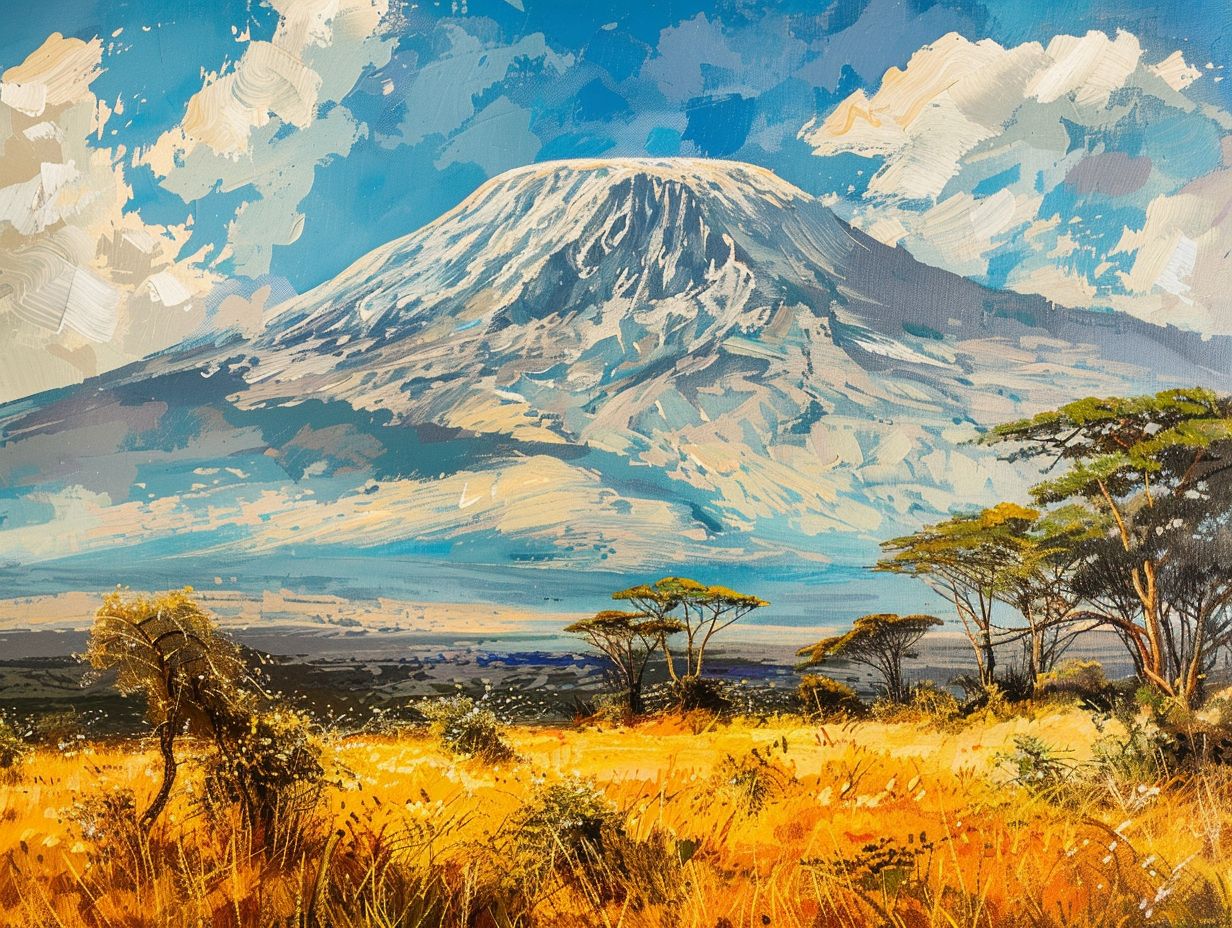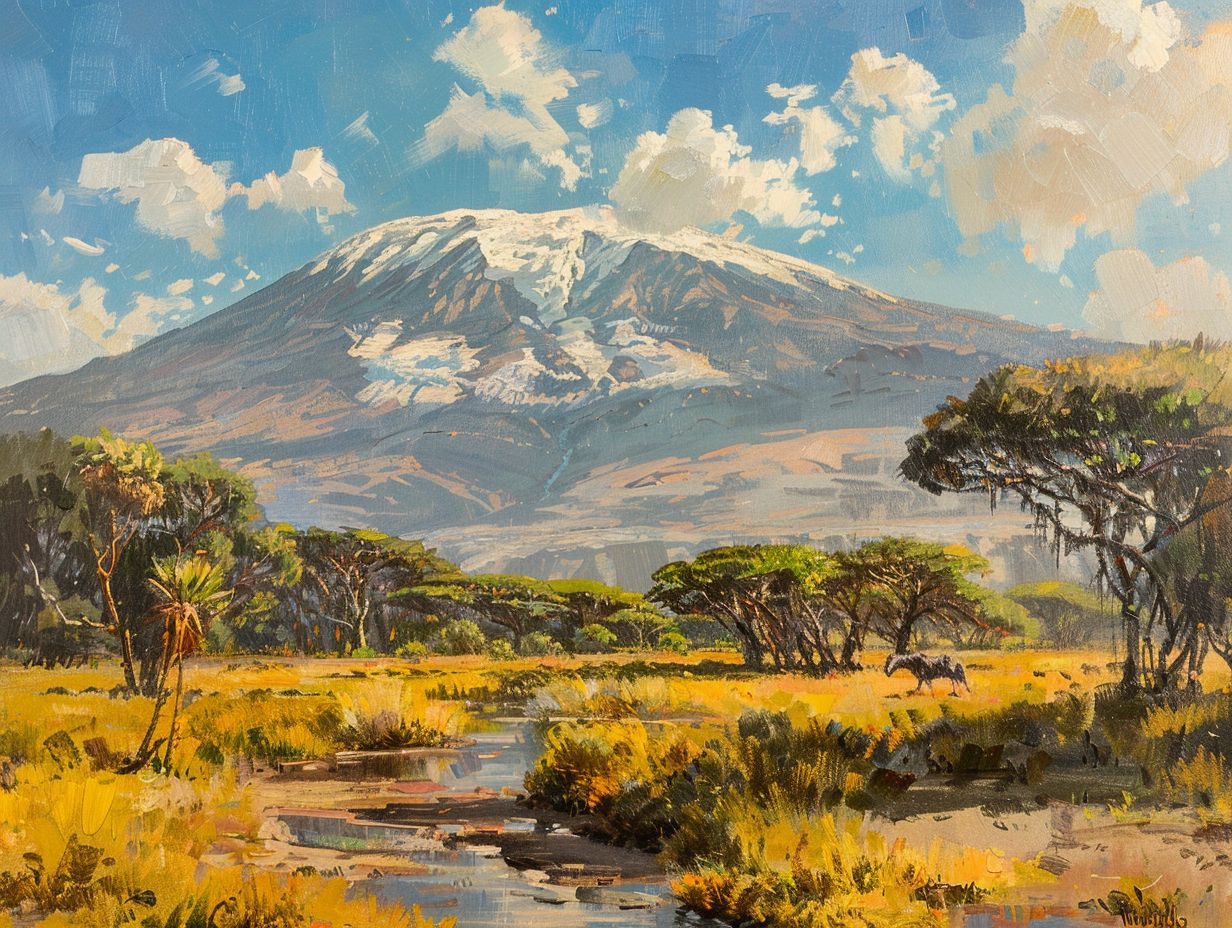
How Tall Is Mount Kilimanjaro?
Mount Kilimanjaro, located in Tanzania, is not just Africa’s tallest peak but also one of the world’s most famous mountains. Determining its exact height has been a topic of debate due to various measurement systems and factors affecting its elevation.
We will explore the different measurement systems used, the official height of Kilimanjaro, how its height has changed over time, the challenges of climbing it, environmental concerns, and the cultural significance and legends surrounding this iconic mountain.
Join us on this journey to uncover the mysteries of Mount Kilimanjaro.
Key Takeaways:

- Mount Kilimanjaro is the highest mountain in Africa, standing at 19,341 feet tall.
- There are different measurement systems used to determine the height of Mount Kilimanjaro, leading to some disagreement about its exact height.
- The official height of Mount Kilimanjaro has changed over time due to factors such as climate change and erosion.
How Tall Is Mount Kilimanjaro?

The height of Mount Kilimanjaro, one of the tallest peaks globally, is a subject of interest and discussion among climbers and geologists due to its association with the African tectonic plates.
Standing majestically as the highest peak in Africa, Mount Kilimanjaro boasts three volcanic cones: Kibo, Mawenzi, and Shira. Its towering summit reaches an impressive 19,340 feet (5,895 meters) above sea level, making it a coveted destination for adventurers seeking the ultimate challenge.
This colossal mountain’s geological significance lies in its formation over millennia, primarily due to the shifting of the African tectonic plate that continues to impact its landscape. The snow-capped summit adds to the allure of this natural wonder, attracting climbers from around the world.
-
What Are The Different Measurement Systems Used To Measure The Height Of Mount Kilimanjaro?
The measurement of Mount Kilimanjaro’s height involves various systems and methodologies, including triangulation, satellite imaging, and ground-based surveys, to determine its precise elevation above sea level.
Triangulation, a traditional method, uses the angles and lengths of a triangle formed by observations from multiple points to calculate the mountain’s height. Satellite imaging, on the other hand, utilizes data from orbiting satellites to create detailed topographic maps.
Ground-based surveys involve researchers physically measuring elevations at specific locations on the mountain. These techniques, combined with advanced technologies like LiDAR (Light Detection and Ranging), offer a comprehensive approach to accurately determining Mount Kilimanjaro’s true height.
-
Why Is There Disagreement About The Height Of Mount Kilimanjaro?

The height discrepancy surrounding Mount Kilimanjaro stems from variations in rock erosion, tectonic movements, and measurement techniques employed over time by researchers and surveyors.
Geological processes play a significant role in the changing height measurements of Mount Kilimanjaro. Erosion, caused by factors such as weathering and glacier movements, can alter the surface levels and impact the recorded height. Tectonic shifts in the Earth’s crust can result in subtle changes in elevation over long periods.
These natural phenomena have led to disagreements among experts when determining the peak’s exact height. Advancements in measurement technologies, from the traditional land surveying methods to modern GPS and satellite imaging, have also contributed to discrepancies in recorded heights.
-
What Is The Official Height Of Mount Kilimanjaro?
The officially recognized height of Mount Kilimanjaro, a symbol of Africa’s majesty, stands as a testament to the continent’s natural wonders and geological heritage.
At 19,341 feet (5,895 meters) above sea level, Mount Kilimanjaro reigns as the highest peak in Africa, drawing adventurers and nature enthusiasts eager to witness its grandeur firsthand. This towering volcanic formation not only showcases the diverse landscapes of the continent but also serves as a beacon of environmental significance.
Its snow-capped summit, contrasting against the African savanna below, symbolizes the coexistence of extremes, making it a visual metaphor for the continent’s dramatic geological history and ecological importance.
-
How Has The Height Of Mount Kilimanjaro Changed Over Time?
The evolutionary journey of Mount Kilimanjaro’s height spans centuries, influenced by volcanic activity, tectonic shifts, and geological transformations that have shaped its majestic summit over time.
Beginning as a stratovolcano millions of years ago, Mount Kilimanjaro experienced various volcanic eruptions that added layers to its structure. These volcanic activities significantly impacted the mountain’s height, altering its size through the eons.
Tectonic movements in the East African Rift System played a crucial role in shaping the region where the mountain stands, causing uplifts and shifts that further affected Kilimanjaro’s elevation. These geological phenomena, combined with erosion and weathering, have contributed to the continuous changes in Kilimanjaro‘s height, making it a dynamic natural marvel to study and admire.
-
What Are The Factors That Can Affect The Height Of A Mountain?
The elevation of a mountain, such as Kilimanjaro, can be influenced by multiple factors including tectonic activity, erosion patterns, volcanic eruptions, and continental drift, all contributing to the dynamic nature of these geological formations.
For instance, tectonic plates shifting beneath the Earth’s surface can cause the gradual rise of a mountain over millions of years as the plates collide or move apart. Similarly, the force of erosion by wind, water, and ice plays a crucial role in sculpting a mountain’s peak and altering its height over time. Volcanic activities, like those that formed Kilimanjaro, can lead to the rapid creation of mountainous terrain due to magma pushing through the Earth’s crust.
-
What Is The Tallest Peak Of Mount Kilimanjaro?
The highest point on Mount Kilimanjaro, known as Uhuru Peak, is the ultimate goal for climbers seeking to conquer the summit and experience the breathtaking views from the roof of Africa.
Standing at an impressive elevation of 5,895 meters (19,341 feet) above sea level, Uhuru Peak not only symbolizes the physical achievement of reaching the summit but also offers a sense of accomplishment and satisfaction to those who brave the challenging climb.
Upon reaching this renowned peak, climbers are rewarded with a sense of elation as they gaze upon the vast expanse of the surrounding landscape and witness the stunning sunrise painting the sky in hues of orange and pink, creating a magical experience that lingers in their memories forever.
-
How Long Does It Take To Climb Mount Kilimanjaro?

The duration to ascend Mount Kilimanjaro varies depending on the chosen route, climber’s fitness level, and acclimatization needs, with typical treks lasting between five to nine days to reach the summit.
One of the critical factors affecting the time taken to summit Kilimanjaro is the selection of the route. Popular options like the Machame Route usually span about six to seven days, offering a good balance of scenery and acclimatization opportunities.
Acclimatization is a key consideration in high-altitude climbing as the body needs time to adjust to the decreasing oxygen levels. Climbers often spend a day or two at certain altitudes to acclimatize, reducing the risk of altitude sickness.
The pace at which an individual treks also impacts the duration. A more leisurely pace allows for better acclimatization and higher chances of a successful summit bid. Faster climbers might opt for quicker routes like the Marangu Route, which typically take five to six days.
-
What Are The Different Routes To Climb Mount Kilimanjaro?
Mount Kilimanjaro presents climbers with a selection of diverse routes including the Marangu, Machame, Lemosho, Rongai, and Northern Circuit, each offering unique challenges and scenic landscapes during the ascent to the summit.
- The Marangu Route, often called the ‘Coca-Cola Route’, is the oldest and most established path on Kilimanjaro, known for its comfortable hut accommodations along the way.
- The Machame Route, also known as the ‘Whiskey Route’, is a popular choice for its diversity of landscapes, from dense rainforest to alpine desert.
- The Lemosho Route offers a more gradual climb with stunning views and lower traffic compared to other paths.
- Rongai Route, starting from the north, is less crowded and provides a unique perspective of the mountain.
- The Northern Circuit combines the Northern slopes with the Western Breach, offering an extended and less-traveled journey on the mountain.
-
What Are The Physical Challenges Of Climbing Mount Kilimanjaro?
Climbing Mount Kilimanjaro poses physical challenges such as altitude sickness, extreme cold, glacier crossings, and strenuous ascents due to the mountain’s varying terrains and high-altitude conditions.
At higher altitudes, climbers often face low oxygen levels, leading to altitude-related issues like dizziness, nausea, and fatigue, making each step a test of endurance and willpower. The glacier traversals can be treacherous, with crevasses and unstable ice, requiring careful navigation skills and teamwork.
Temperature extremes add another layer of difficulty, swinging from scorching heat during the day to freezing cold nights, necessitating appropriate gear and preparation.
-
What Are The Environmental Concerns Surrounding Mount Kilimanjaro?
Mount Kilimanjaro faces environmental challenges such as glacier retreat, deforestation, ecosystem disruption, and waste accumulation, highlighting the pressing need for sustainable conservation efforts to preserve its natural beauty and biodiversity.
The glacier retreat on Mount Kilimanjaro is a visible reminder of the impact of climate change, as the iconic ice cap continues to shrink at an alarming rate. Deforestation poses a significant threat to the mountain’s ecosystem, leading to soil erosion and habitat loss for unique species.
Habitat disturbances disrupt the delicate balance of the mountain’s flora and fauna, endangering their survival.
Addressing these ecological challenges requires comprehensive conservation strategies, including reforestation initiatives, waste management plans, and sustainable tourism practices. Efforts to mitigate pollution issues and promote environmental awareness are crucial in safeguarding the fragile environment of Mount Kilimanjaro for future generations.
-
What Are The Cultural Significance And Legends Associated With Mount Kilimanjaro?
Mount Kilimanjaro holds a revered place in local cultures and traditions, embodying a symbol of national pride and inspiring awe through ancient legends and historical expeditions led by explorers like Hans Meyer and Ludwig Purtscheller.
The majestic peak of Kilimanjaro, rising almost magically above the Tanzanian landscape, is steeped in folklore and revered by local tribes as a sacred entity representing the connection between heaven and earth. Tales of mythical beings residing on its slopes are passed down through generations, adding to the mountain’s mystique.
The legendary figures of explorers Hans Meyer and Ludwig Purtscheller, who conquered its challenging heights in the late 19th century, symbolize bravery and determination in the face of adversity.
Frequently Asked Questions:
1. How tall is Mount Kilimanjaro?
A: Mount Kilimanjaro is approximately 19,341 feet tall, making it the tallest mountain in Africa.
2. What units are used to measure the height of Mount Kilimanjaro?
A: The height of Mount Kilimanjaro is typically measured in feet, but it can also be measured in meters, which is approximately 5,895 meters.
3. Is Mount Kilimanjaro the tallest mountain in the world?
A: No, Mount Kilimanjaro is not the tallest mountain in the world. It is the tallest mountain in Africa and the highest free-standing mountain in the world.
4. How long does it take to climb Mount Kilimanjaro?
A: The average time it takes to climb Mount Kilimanjaro is 7-9 days, depending on the chosen route and the individual’s physical fitness.
5. Are there any age restrictions for climbing Mount Kilimanjaro?
A: There are no official age restrictions for climbing Mount Kilimanjaro, but it is recommended for individuals aged 10 and above. However, it is important to consult with a doctor before attempting the climb.
6. Is it possible to see the peak of Mount Kilimanjaro from the base?
A: Yes, on a clear day, it is possible to see the peak of Mount Kilimanjaro from the base. However, the peak can also be covered in clouds, making it difficult to see at times.